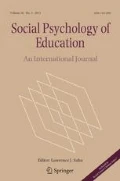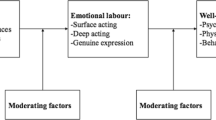Abstract
While the similarities between emotion regulation (Gross in J Personal Soc Psychol 74:224–237, 1998a) and emotional labor (Hochschild in The managed heart: commercialization of human feeling. University of California Press, Berkeley, 1983) have been theoretically discussed, empirical research on their relation is lacking. We examined the relations between the two constructs as well as their relations with teachers’ discrete emotions in a sample of 189 secondary school teachers. The results showed that reappraisal correlated positively with deep acting, whereas suppression correlated positively with surface acting. The findings further suggest that reappraisal and deep acting are linked to experiencing positive emotions, whereas suppression and surface acting are linked to experiencing negative emotions. However, there also were some differences in how emotion regulation and emotional labor were related to teachers’ discrete emotional experiences. Specifically, reappraisal and deep acting strategies were positively related to enjoyment; in addition, deep acting was negatively related to negative emotions such as anxiety, anger, and frustration. By contrast, suppression and surface acting strategies were positively associated with negative emotions (i.e., suppression with anxiety; surface acting with anxiety, anger, and frustration), and surface acting was negatively associated with the positive emotion enjoyment. Implications for integrating research on teachers’ emotion regulation and emotional labor are discussed.

Similar content being viewed by others
References
Abler, B., & Kessler, H. (2009). Emotion regulation questionnaire—Eine deutsche version des ERQ von Gross & John. Diagnostica, 55(3), 144–152.
Bentler, P. M. (1990). Comparative fit indexes in structural models. Psychological Bulletin, 107, 238–246.
Bono, J. E., & Vey, M. A. (2005). Toward understanding emotional management at work: A quantitative review of emotional labor research. In C. E. J. Hartel, W. J. Zerbe, & N. M. Ashkanasy (Eds.), Emotions in organizational behavior (pp. 213–234). Mahwah: Lawrenece Erlbaum Associates Inc.
Brackett, M. A., Palomera, R., Mojsa-Kaja, J., Reyes, M. R., & Salovy, P. (2010). Emotion-regulation ability, burnout, and job satisfaction among British secondary-school teachers. Psychology in the Schools, 47(4), 406–417.
Brotheridge, C., & Grandey, A. (2002). Emotional labor and burnout: Comparing two perspectives of “people work”. Journal of Vocational Behavior, 60, 17–39.
Brotheridge, C. M., & Lee, R. T. (2002). Testing a conservation of resources model of the dynamics of emotional labor. Journal of Occupational Health Psychology, 7, 57.
Brotheridge, C. M., & Lee, R. T. (2003). Development and validation of the emotional labor scale. Journal of Occupational and Organizational Psychology, 76(3), 365–379.
Diefendorff, J. M., Croyle, M. H., & Gosserand, R. H. (2005). The dimensionality and antecedents of emotional labor strategies. Journal of Vocational Behavior, 66(2), 339–359.
Diefendorff, J. M., Richard, E. M., & Yang, J. (2008). Linking emotion regulation strategies to affective events and negative emotions at work. Journal of Vocational Behavior, 73(3), 498–508.
Emmer, E. T., & Stough, L. M. (2001). Classroom management: A critical part of educational psychology, with implications for teacher education. Educational Psychology, 3, 103–112.
Frenzel, A. C., Goetz, T., Stephens, E. J., & Jacob, B. (2009). Antecedents and effects of teachers’ emotional experiences: An integrated perspective and empirical test. In P. A. Schutz & M. Zembylas (Eds.), Advances in teacher emotion research: The impact on teachers’ lives (pp. 129–151). New York: Springer.
Frenzel, A. C., Pekrun, R., & Goetz, T. (2010). Achievement Emotions Questionnaire for teachers (AEQ-teacher)—User’s manual. Munich: University of Munich: Department of Psychology.
Fried, L. (2011). Teaching teachers about emotion regulation in the classroom. Australian Journal of Teacher Education, 36, 117–127.
Grandey, A. A. (2000). Emotion regulation in the workplace: A new way to conceptualize emotional labor. Journal of Occupational Health Psychology, 5, 95–110.
Grandey, A. A. (2003). When “the show must go on”: Surface acting and deep acting as determinants of emotional exhaustion and peer-rated service delivery. Academy of Management Journal, 46, 86–96.
Grandey, A. A. (2015). Smiling for a wage: What emotional labor teaches us about emotion regulation. Psychological Inquiry, 26(1), 54–60.
Gross, J. J. (1998a). Antecedent- and response-focused emotion regulation: Divergent consequences for experience, expression and physiology. Journal of Personality and Social Psychology, 74, 224–237.
Gross, J. J. (1998b). The emerging field of emotion regulation: An integrative review. Review of General Psychology, 2(3), 271–299.
Gross, J. J. (2001). Emotion regulation in adulthood: Timing is everything. Current Directions in Psychological Science, 10(6), 214–219.
Gross, J. J. (2002). Emotion regulation: Affective, cognitive, and social consequences. Psychophysiology, 39, 281–291.
Gross, J. J., & John, O. P. (2003). Individual differences in two emotion regulation processes: Implications for affect, relationships, and well-being. Journal of Personality and Social Psychology, 85(2), 348–362.
Gross, J. J., Richards, J. M., & John, O. P. (2006). Emotion regulation in everyday life. In D. K. Snyder, J. A. Simpson, & J. N. Hughes (Eds.), Emotion regulation in families: Pathways to dysfunction and health (pp. 13–35). Washington: American Psychological Association.
Haga, S. M., Kraft, P., & Corby, E. K. (2009). Emotion regulation: Antecedents and well-being outcomes of cognitive reappraisal and expressive suppression in cross-cultural samples. Journal of Happiness Studies, 10(3), 271–291.
Hargreaves, A. (1998). The emotional practice of teaching. Teaching and Teacher Education, 14, 835–854.
Hargreaves, A. (2000). Mixed emotions: Teachers’ perceptions of their interactions with students. Teaching and Teacher Education, 16(8), 811–826.
Hochschild, A. R. (1983). The managed heart: Commercialization of human feeling. Berkeley: University of California Press.
Hochschild, A. R. (1990). Ideology and emotion management: A perspective and path for future research. In T. Kemper (Ed.), Research agendas in the sociology of emotions. Albany: State University of New York State.
Hu, L.-T., & Bentler, P. M. (1999). Cutoff criteria for fit indexes in covariance structure analysis: Conventional criteria versus new alternatives. Structural Equation Modeling, 6, 1–55.
Hülsheger, U. R., & Schewe, A. F. (2011). On the costs and benefits of emotional labor: A meta-analysis of three decades of research. Journal of Occupational Health Psychology, 16(3), 361.
Johnson, H. A. M., & Spector, P. E. (2007). Service with a smile: Do emotional intelligence, gender, and autonomy moderate the emotional labor process? Journal of Occupational Health Psychology, 12(4), 319.
Lance, C. E., Butts, M. M., & Michels, L. C. (2006). The sources of four commonly reported cutoff criteria: What did they really say? Organizational Research Methods, 9, 202–220.
Lee, R. T., & Brotheridge, C. M. (2006). Validation and extension of the emotional labor scale: Evidence from daycare workers. Paper presented at the EMONET conference, Atlanta, GA.
Lee, R. T., Lovell, B. L., & Brotheridge, C. M. (2010). Tenderness and steadiness: Relating job and interpersonal demands and resources with burnout and physical symptoms of stress in Canadian physicians. Journal of Applied Social Psychology, 40(9), 2319–2342.
Matsumoto, D., Yoo, S. H., & Nakagawa, S. (2008). Culture, emotion regulation, and adjustment. Journal of Personality and Social Psychology, 94(6), 925.
Mikolajczak, M., Tran, V., Brotheridge, C. M., & Gross, J. J. (2009). Using an emotion regulation framework to predict the outcomes of emotional labor. Research on Emotion in Organizations, 5, 245–273.
Muthén, L. K., & Muthén, B. O. (1998–2012). Mplus user’s guide (6th ed). Los Angeles: Muthén & Muthén.
Näring, G., Briët, M., & Brouwers, A. (2006). Beyond demand–control: Emotional labor and symptoms of burnout in teachers. Work and Stress, 20, 303–315.
Philipp, A., & Schüpbach, H. (2010). Longitudinal effects of emotional labour on emotional exhaustion and dedication of teachers. Journal of Occupational Health Psychology, 15(4), 494–504.
Schutz, P. A., & Zembylas, M. (Eds.). (2009). Advances in teacher emotion research: The impact on teachers’ lives. New York: Springer.
Steiger, J. H., & Lind, J. C. (1980). Statistically based tests for the number of common factors. Paper presented at the annual Spring Meeting of the Psychometric Society, Iowa City.
Sutton, R. E. (2004). Emotional regulation goals and strategies of teachers. Social Psychology of Education, 7(4), 379–398.
Sutton, R. E. (2007). Teachers’ anger, frustration, and self-regulation. In P. A. Schutz & R. Pekrun (Eds.), Emotion in education (pp. 251–266). San Diego: Elsevier Academic Press.
Sutton, R. E., & Harper, E. (2009). Teachers’ emotion regulation. In L. J. Saha & A. G. Dworkin (Eds.), International handbook of research on teachers and teaching (pp. 389–401). US: Springer.
Sutton, R. E., & Knight, C. C. (2006, April). Assessing teachers’ emotion regulation. Paper presented at the American Educational Research Association Meeting, San Francisco.
Sutton, R. E., Mudrey-Camino, R., & Knight, C. C. (2009). Teachers’ emotion regulation and classroom management. Theory Into Practice, 48(2), 130–137.
Sutton, R. E., & Wheatley, K. F. (2003). Teachers’ emotions and teaching: A review of the literature and directions for future research. Educational Psychology Review, 15(4), 327–358.
Taxer, J. L., & Frenzel, A. C. (2015). Facets of teachers’ emotional lives: A quantitative investigation of teachers’ genuine, faked, and hidden emotions. Teaching and Teacher Education, 49, 78–88.
Trigwell, K. (2009). Relations between teachers’ emotions in teaching and their approaches to teaching in higher education: A pilot study. Paper presented at 13th conference of the European Association for Research on Learning and Instruction. Amsterdam, Netherlands.
Tucker, L. R., & Lewis, C. (1973). A reliability coefficient for maximum likelihood factor analysis. Psychometrika, 3, 1–10.
Williams-Johnson, M. W., Cross, D. I., Hong, J. Y., Aultman, L. P., Osbon, J. N., & Schutz, P. A. (2008). “There is no emotion in math”: How teachers approach emotions in the classroom. Teacher College Record, 110(8), 1574–1612.
Zembylas, M. (2003). Emotions and teacher identity: A poststructural perspective. Teachers and Teaching, 9(3), 213.
Acknowledgments
We would like to thank Anne C. Frenzel for her valuable comments on an earlier version of this manuscript, and Wolfgang Sack, Teresa Schirmbeck, Stefan Hauser, and Cornelia Meyer for their assistance in the data collection.
Author information
Authors and Affiliations
Corresponding author
Rights and permissions
About this article
Cite this article
Lee, M., Pekrun, R., Taxer, J.L. et al. Teachers’ emotions and emotion management: integrating emotion regulation theory with emotional labor research. Soc Psychol Educ 19, 843–863 (2016). https://doi.org/10.1007/s11218-016-9359-5
Received:
Accepted:
Published:
Issue Date:
DOI: https://doi.org/10.1007/s11218-016-9359-5




